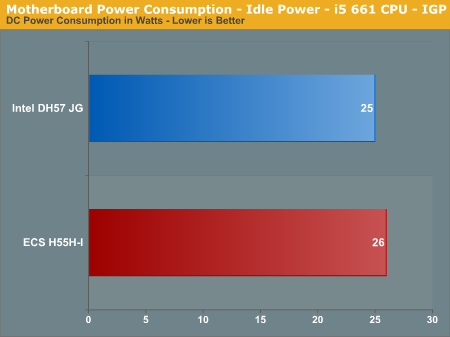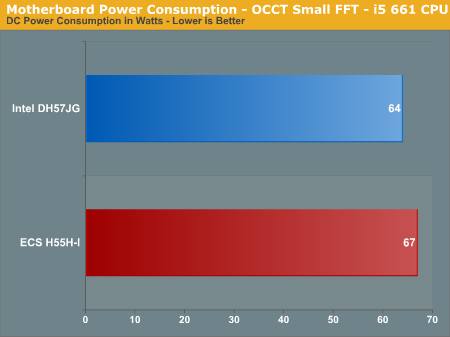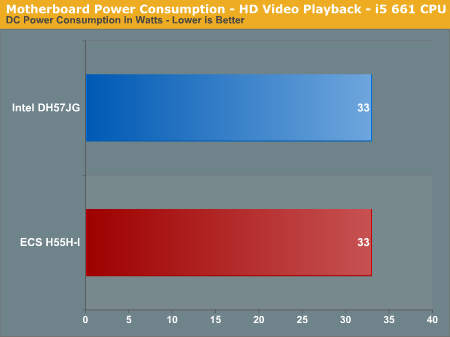ECS H55H-I Review: Mini-ITX at a Sensible Price
by Rajinder Gill on May 6, 2010 6:59 AM EST- Posted in
- Motherboards
|
Testbed Setup Overclocking / Benchmark Testbed |
|
| Processor |
1 x Intel i7 870 ES CPU |
| CPU Voltage | Various |
| Cooling | Intel air cooler, Heatkiller 3.0 waterblock, PA120.2 radiator and DDC ultra pump (with Petra top), 1/2 ID tubing for watercooling. |
| Power Supply | Corsair HX950 |
| Memory |
Corsair Dominator GT 8-8-8-24 2200MHz 4GB kit G.Skill Perfect Storm 8-8-8-24 2200MHz 4GB kit. |
| Memory Settings | Various |
| Video Cards | MSI 275 Lightning (stock clocks) |
| Video Drivers | nVidia 195.62 WHQL |
| Hard Drive |
Western Digital 7200RPM 1TB SATA 3/Gbps 32MB Buffer OCZ Vertex 120GB SSD |
| Optical Drives | Plextor PX-B900A, Toshiba SD-H802A |
| Case |
Open Test Bed - Dimastech Benching Station Lian-Li V2110 |
| Operating System | Windows 7 64 bit |
| . | |
We utilized memory kits from Corsair and G.Skill to verify memory compatibility on our test boards. Our OS and primary applications are loaded on the OCZ Vertex 120GB SSD drive and our games operate off the WD Caviar Black 1TB drive. We did a clean install of the OS and applications for each motherboard. We used Intel's stock cooler for the stock comparison testing, while water-cooling via the superlative Heat Killer 3.0 water block was utilized for overclocking. For graphics duty, MSI’s GTX 275 Lighting GPU was used to provide performance comparisons between boards during gaming benchmarks.
For our test results we set up each board as closely as possible in regards to memory timings. Otherwise all other settings are left on auto. The P55 utilized 8GB of memory where possible, while the X58 platform contained 6GB. The P55 and X58 DDR3 timings were set to 7-7-7-20 1T at DDR3-1600 for the i7-920 and i7-870 processors at both stock and overclocked CPU settings.
We used DDR3-1333 6-6-6-18 1T timings for the i5-750 stock setup for all system benchmarks (non-gaming tests) as DDR3-1600 is not natively supported at a stock BCLK setting of 133. For our Clarkdale i5 661 and i3 540 CPU’s, we used 7-7-7-20 1N timings at DDR3-1333MHz with 8GB of memory (4GB on the Mini-ITX boards).
Power Consumption
Our power consumption testing utilizes the same batch of components under similar circumstances in a bid to monitor variances between idle and CPU load conditions. We install the vendor supplied power saving utilities on each board and enable power saving modes that don't involve any kind of underclocking or CPU core frequency modulation in order to run an apples to apples comparison.
ATX PSU switching losses are absent from our figures because we monitor power consumption directly at the DC rails of the PSU. These figures measure only the CPU, motherboard and memory DC power draw and exclude any other peripherals, such as cooling fans and hard drives etc. Actual AC power consumption for the motherboard will be anywhere from 15~40% higher than these figures depending upon the efficiency of your power supply.



There's no reason to choose one board over the other based upon the differences we're seeing here - a three watt difference under full-load is not worth worrying about.










67 Comments
View All Comments
nubie - Thursday, May 6, 2010 - link
The industrial market uses (used?) ISA cards.Try Soyo, Supermicro, and Jetway for industry boards.
Powerlurker - Thursday, May 6, 2010 - link
http://adek.com/ATX-motherboards.htmlI needed to spec one a couple years ago for a piece of lab equipment (I too work in a chemistry lab). It looks like this is the website for the motherboard manufacturer. http://www.commell.com.tw/Product/SBC/P4BWA.HTM
nubie - Thursday, May 6, 2010 - link
How could I forget Commell,Thanks :)
kmmatney - Friday, May 7, 2010 - link
I've purchased several of the ADEK boards to support some old ISA motion controllers we have. The motherboards are around $300, while a new motion controller (these are quite advanced) would have cost about $4000. They work great!Earthmonger - Thursday, May 6, 2010 - link
Really, it is. I could previously count the number of socket 1156 ITX boards on one hand. This ECS is a welcome addition."However, if you're thinking of overclocking with this board, we'd say that ECS is a couple of BIOSes away from a glowing recommendation"
What ITX board would you recommend for overclocking, then? 'Cause I'm always thinking about it. Where's that EVGA ITX powerhouse at? lol
Rajinder Gill - Thursday, May 6, 2010 - link
Hi,Unfortuantely, all mini-ITX boards are limited in one way or another. Either by voltage options (insufficent current handling capacity), and/or the need of some BIOS polish as in the case of ECS.. I'm hoping we see someone put a 180amp capable VRM on one of these baords soon...lol
regards
Raja
MadMan007 - Thursday, May 6, 2010 - link
Yes that would be nice and I don't buy the 'limited space' argument either. There are plenty of good overclocking microATX boards that don't use a ton of space for VRMs. I was hoping DFI would push things in this area but not yet...maybe since they are supposedly focusing on smaller form factors going forward they will.JonnyDough - Thursday, May 6, 2010 - link
Well, not quite legacy free. Isn't that a VGA connector? :)DanNeely - Thursday, May 6, 2010 - link
Mostly it matters for people doing low level OS development because PS2 requires much less software support than USB. If you're not hacking the linux kernel/porting it to new hardware it, along with RS232 are only really needed for high price hardware interfaces.lwatcdr - Thursday, May 6, 2010 - link
PS/2 ports and legacy serial and parallel ports can be a very important.Remember this is a Mini-ITX board. A good number of these end up in industrial settings.
Things like CNC machines, and lab equipment use good old serial and parallel ports to interface. They may also have a custom front panel that uses a PS/2 interface.
Even floppy's are still used on some systems like that and some of the software for them even runs under dos!
For a nettop or desktop you are correct. They less than useful but there is a large market segment that will need them for a long time. BTW USB to serial converters tend to be crap.